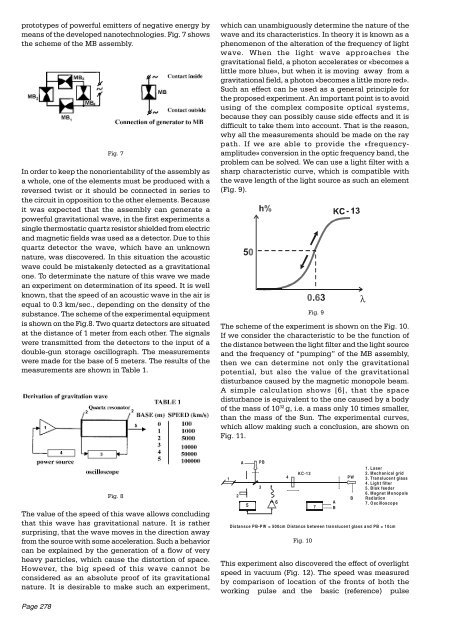Reactionless Propulsion and Active Force - Practical Guide to Free ...
Reactionless Propulsion and Active Force - Practical Guide to Free ...
Reactionless Propulsion and Active Force - Practical Guide to Free ...
Create successful ePaper yourself
Turn your PDF publications into a flip-book with our unique Google optimized e-Paper software.
pro<strong>to</strong>types of powerful emitters of negative energy by<br />
means of the developed nanotechnologies. Fig. 7 shows<br />
the scheme of the MB assembly.<br />
Page 278<br />
Fig. 7<br />
In order <strong>to</strong> keep the nonorientability of the assembly as<br />
a whole, one of the elements must be produced with a<br />
reversed twist or it should be connected in series <strong>to</strong><br />
the circuit in opposition <strong>to</strong> the other elements. Because<br />
it was expected that the assembly can generate a<br />
powerful gravitational wave, in the first experiments a<br />
single thermostatic quartz resis<strong>to</strong>r shielded from electric<br />
<strong>and</strong> magnetic fields was used as a detec<strong>to</strong>r. Due <strong>to</strong> this<br />
quartz detec<strong>to</strong>r the wave, which have an unknown<br />
nature, was discovered. In this situation the acoustic<br />
wave could be mistakenly detected as a gravitational<br />
one. To determinate the nature of this wave we made<br />
an experiment on determination of its speed. It is well<br />
known, that the speed of an acoustic wave in the air is<br />
equal <strong>to</strong> 0.3 km/sec., depending on the density of the<br />
substance. The scheme of the experimental equipment<br />
is shown on the Fig.8. Two quartz detec<strong>to</strong>rs are situated<br />
at the distance of 1 meter from each other. The signals<br />
were transmitted from the detec<strong>to</strong>rs <strong>to</strong> the input of a<br />
double-gun s<strong>to</strong>rage oscillograph. The measurements<br />
were made for the base of 5 meters. The results of the<br />
measurements are shown in Table 1.<br />
Fig. 8<br />
The value of the speed of this wave allows concluding<br />
that this wave has gravitational nature. It is rather<br />
surprising, that the wave moves in the direction away<br />
from the source with some acceleration. Such a behavior<br />
can be explained by the generation of a flow of very<br />
heavy particles, which cause the dis<strong>to</strong>rtion of space.<br />
However, the big speed of this wave cannot be<br />
considered as an absolute proof of its gravitational<br />
nature. It is desirable <strong>to</strong> make such an experiment,<br />
which can unambiguously determine the nature of the<br />
wave <strong>and</strong> its characteristics. In theory it is known as a<br />
phenomenon of the alteration of the frequency of light<br />
wave. When the light wave approaches the<br />
gravitational field, a pho<strong>to</strong>n accelerates or «becomes a<br />
little more blue», but when it is moving away from a<br />
gravitational field, a pho<strong>to</strong>n «becomes a little more red».<br />
Such an effect can be used as a general principle for<br />
the proposed experiment. An important point is <strong>to</strong> avoid<br />
using of the complex composite optical systems,<br />
because they can possibly cause side effects <strong>and</strong> it is<br />
difficult <strong>to</strong> take them in<strong>to</strong> account. That is the reason,<br />
why all the measurements should be made on the ray<br />
path. If we are able <strong>to</strong> provide the «frequencyamplitude»<br />
conversion in the optic frequency b<strong>and</strong>, the<br />
problem can be solved. We can use a light filter with a<br />
sharp characteristic curve, which is compatible with<br />
the wave length of the light source as such an element<br />
(Fig. 9).<br />
The scheme of the experiment is shown on the Fig. 10.<br />
If we consider the characteristic <strong>to</strong> be the function of<br />
the distance between the light filter <strong>and</strong> the light source<br />
<strong>and</strong> the frequency of “pumping” of the MB assembly,<br />
then we can determine not only the gravitational<br />
potential, but also the value of the gravitational<br />
disturbance caused by the magnetic monopole beam.<br />
A simple calculation shows [6], that the space<br />
disturbance is equivalent <strong>to</strong> the one caused by a body<br />
of the mass of 10 32 g, i.e. a mass only 10 times smaller,<br />
than the mass of the Sun. The experimental curves,<br />
which allow making such a conclusion, are shown on<br />
Fig. 11.<br />
1<br />
2<br />
A<br />
5<br />
PB<br />
3<br />
6<br />
4<br />
KC-13<br />
Fig. 9<br />
7<br />
This experiment also discovered the effect of overlight<br />
speed in vacuum (Fig. 12). The speed was measured<br />
by comparison of location of the fronts of both the<br />
working pulse <strong>and</strong> the basic (reference) pulse<br />
A<br />
B<br />
PW<br />
B<br />
1. Laser<br />
2. Mechanical grid<br />
3. Translucent glass<br />
4. Light filter<br />
5. Blok feeder<br />
6. Mag net Monopole<br />
Radiation<br />
7. Oscilloscope<br />
Distansce PB-PW = 500cm Distance between translucent glass <strong>and</strong> PB = 10cm<br />
Fig. 10

















